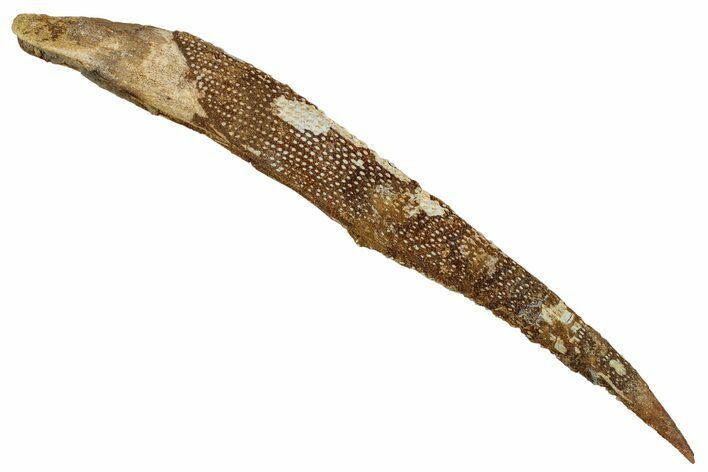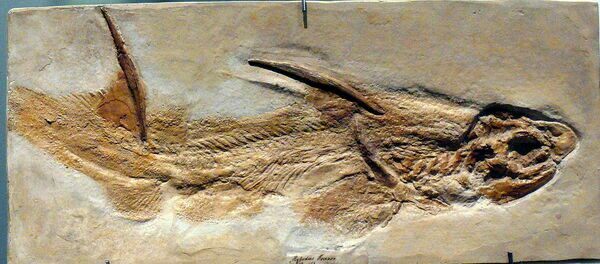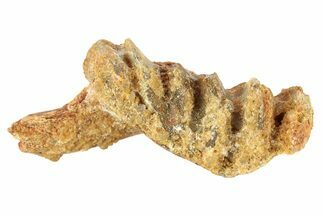This Specimen has been sold.
9" Fossil Shark (Asteracanthus) Dorsal Spine - Kem Kem Beds
This is a large, 9" long, fossil, dorsal spine of a shark (Asteracanthus ornatissimus). It comes from the Late Cretaceous, Kem Kem Beds near Taouz, Morocco. There are two hybodontiform sharks whose spines are found in this formation with Asteracanthus being the rarer of the two.
It has several repaired cracks along its length as these spines are fairly delicate and typically are found fractured. The final 1" of its tip has been restored.
It has several repaired cracks along its length as these spines are fairly delicate and typically are found fractured. The final 1" of its tip has been restored.
Hybodus was a small shark that grew up to 2 meters in length and was likely an opportunistic predator. It had a streamlined shape ideal for hunting down fast prey and two different types of teeth: sharp cutting teeth for catching prey and flatter grinding teeth for crushing. This combination may have been the key to Hybodus' success.
A paper on Hybodus spines can be found below.
Growth And Form of Finspines In Hybodont Sharks
A paper on Hybodus spines can be found below.
Growth And Form of Finspines In Hybodont Sharks
The Kem Kem Group
The Kem Kem Group, also known as the Kem Kem Beds, is a significant geological formation located in southeastern Morocco, specifically in the region of the Anti-Atlas Mountains. This formation dates back to the late Cretaceous period, approximately 95 million years ago. The Kem Kem Beds are primarily composed of sandstone, siltstone, and claystone, interspersed with various sedimentary features that indicate a fluvial to deltaic environment.
The Kem Kem Group is renowned for its rich fossil deposits, which include a diverse array of prehistoric fauna. It has yielded a wide variety of dinosaur fossils, including theropods like Spinosaurus and Carcharodontosaurus, as well as large Sauropod dinosaurs such as Rebbachisaurus. Additionally, the beds are home to many other fossilized creatures, including crocodiles, pterosaurs, fish, and a range of invertebrates.
Paleontologists consider the Kem Kem Group an important site for studying late Cretaceous ecosystems and the evolution of vertebrate life. The fossils found in this region have provided valuable insights into the diversity and behavior of prehistoric species, making it a key location for both scientific research and fossil collecting. The striking landscapes of the Kem Kem Beds, with their colorful rock formations and dramatic geological features, also attract geologists and tourists interested in the natural history of the area.
A paper on this assemblage can be found at: Vertebrate assemblages from the early Late Cretaceous of southeastern Morocco: An overview
The Kem Kem Group, also known as the Kem Kem Beds, is a significant geological formation located in southeastern Morocco, specifically in the region of the Anti-Atlas Mountains. This formation dates back to the late Cretaceous period, approximately 95 million years ago. The Kem Kem Beds are primarily composed of sandstone, siltstone, and claystone, interspersed with various sedimentary features that indicate a fluvial to deltaic environment.
The Kem Kem Group is renowned for its rich fossil deposits, which include a diverse array of prehistoric fauna. It has yielded a wide variety of dinosaur fossils, including theropods like Spinosaurus and Carcharodontosaurus, as well as large Sauropod dinosaurs such as Rebbachisaurus. Additionally, the beds are home to many other fossilized creatures, including crocodiles, pterosaurs, fish, and a range of invertebrates.
Paleontologists consider the Kem Kem Group an important site for studying late Cretaceous ecosystems and the evolution of vertebrate life. The fossils found in this region have provided valuable insights into the diversity and behavior of prehistoric species, making it a key location for both scientific research and fossil collecting. The striking landscapes of the Kem Kem Beds, with their colorful rock formations and dramatic geological features, also attract geologists and tourists interested in the natural history of the area.
A paper on this assemblage can be found at: Vertebrate assemblages from the early Late Cretaceous of southeastern Morocco: An overview
SPECIES
Asteracanthus ornatissimus
LOCATION
Taouz, Kem Kem Basin, Morocco
FORMATION
Kem Kem Beds
SIZE
9" long
CATEGORY
ITEM
#244539
We guarantee the authenticity of all of our specimens.
 Reviews
Reviews













